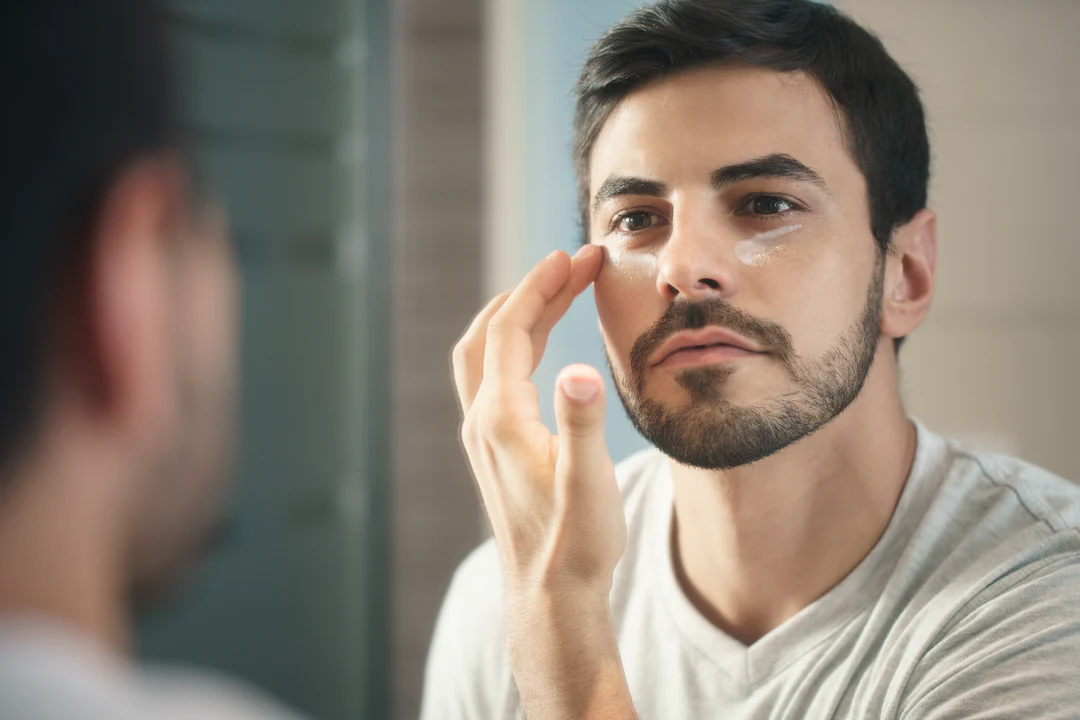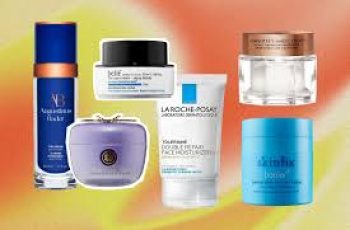Can You Use Retinol Near Eyes?
There really isn’t anything retinol can’t tackle. Blemishes? Not a problem, fine lines, and wrinkles? A thing of the past, dull and lack lustre complexion? Nothing to worry about. Yes, there’s no denying that retinol is a clever ingredient which explains why so many of us have introduced it into our everyday skincare routine.
The question we have, however, is there an area of the skin that we should avoid with this potent powerhouse? It is well known that the area around the eyes is the first to show signs of ageing, with fine lines and crow’s feet becoming more prominent over time. Other concerns, such as under-eye circles and eye bags are also something that can look worse due to the skin around the eye area being thinner, 40% thinner than the rest of the skin on the face to be exact. So, with this in mind, let’s investigate whether you can use retinol near your eyes and the results you can expect to see.
Can you use retinol around the eyes?
Yes, it is perfectly safe and effective to use retinol around the eyes, ensuring you are using the right products that can deliver results without causing any irritation or an allergic reaction.
Admittedly there are some outdated research still floating around suggesting that using eye cream formulas containing potent ingredients should be avoided, but that isn’t really the case anymore. In fact, what you’ll find is that retinol is the number one ingredient suggested by those in the know to help combat signs of ageing, dark circles, and under-eye bags.
Modern day eye cream formulas containing retinol will contain a lower percentage than those found in products used on the rest of the face. These formulas also usually are enriched with other hydrating actives, such as hyaluronic acid to counteract any drying side effects that are a common problem for those using retinol. Before you go throwing away the eye cream you already have, you can layer this with another retinol product, simply mix your eye cream and retinol together and apply under the eyes.
Is retinol good for under eye wrinkles?
Absolutely, as I have already mentioned, retinol is a favourite ingredient amongst skincare experts and dermatologists to help combat signs of ageing, dark circles, and under-eye bags. Retinol can work in the lower layers of the skin, reaching past the epidermis and work at boosting the production of collagen. With more collagen helping the skin appear plumped and more youthful you’ll find that the appearance fine lines and wrinkles are reduced significantly.
How close to eyes can you put retinol?
With the skin around the eye area being notably thinner than the rest of the face, you’ll find it is able to absorb into the skin quickly which can potentially lead to skin irritation which is why you need to remain mindful of how you apply retinol around the eyes. Here are some examples of how to apply retinol to the eyes whilst taking the proper precautions.
Start with a pea size amount of retinol product.
Ensure you are using product that has been formulated for application around the eyes.
Use your ring fingers to apply the product as you naturally apply the least pressure which avoids any skin tugging.
Gentle dab the product around the eye area starting under the eye and working up towards the outer corners, and up to the eyebrows.
Avoid taking the retinol up to the lash line as this can cause potential irritation.
Don’t forget to use your retinol eye cream in your evening routine as exposure to UV light will make retinol lose its potency.
Ensure you follow this with an SPF of 30 and higher in the morning.
Is retinol good for eye bags?
Yes, it is ideal for using to help combat eye bags, especially if the product has retinol combined with hydrating ingredients such as hyaluronic acid or niacinamide. You’ll notice a difference after 3 to 4 weeks with eye bags significantly reduced and the area around the eyes are firmer and look brighter.
Retinol is particularly helpful for using around the eye area as the under-eyes can begin to look sunken with dark circles becoming more noticeable, for some these are signs of lack of sleep, or the position you sleep, others it’s connected to their heritage. Whichever the cause of these are they are combatted with the help of retinol.
Are retinol eye creams safe?
Yes, they are, even with retinol being so potent there is doubt whether it should be used on the delicate eye area. Not to worry, as retinol enriched eye creams often contain a lower percentage and blended with hyaluronic acid or another moisturising ingredient. The bonus that hyaluronic acid can deliver humectant traits meaning it is able to draw water and locking it into the surface layer of the skin and combat any potential sign of irritation and drying effects that occur.
Remember that if you are using retinol for the first time you should introduce into your routine slowly and in the correct way. This should be done after performing a patch test and consulting with your doctor to ensure retinol is the best ingredient for you and your skin.
Can retinol make dark circles worse?
Yes, long-term, and overzealous application of a retinol product around the eye area can make dark circles look worse. This is a result of the side effects that occur when applying retinol to the skin, which are often red, flaky rings around the eye area that once become healed will appear dark. To avoid this, try using retinol every other day, only apply it in the evenings, and don’t forget to use a daily SPF of 30 and above every day, even on a day that looks gloomy.
What happens if you use retinol and go in the sun?
Retinol is highly sensitive to any exposure to sunlight making it lose its potency and effectiveness to deliver results on the skin. It is advised by all skin experts that retinol application should happen in the evening allowing the potent active to work undisturbed throughout the night whilst you get your beauty sleep.
I hope that you now have a better understanding of using retinol near the eyes, don’t forget we are over on Instagram if you have any skincare questions.
DQH Knowledge drop: In your 20s, your skin cell turnover decreases. (Cell turnover is a key component in keeping your skin youthful.) You know what else slows down? Your collagen production. Starting in your 20s, collagen decreases by about 1 percent per year. Should you want to prevent fine lines and wrinkles, start by eliminating behaviors that contribute to premature aging. “If it’s bad for you, it’s bad for your skin,” says dermatologist Michel Somenek.
“Cigarette smoking reduces blood flow to the skin and causes premature wrinkling and a dull skin texture. Making the repeated pursed motion to inhale can also cause smoker’s lines. Alcohol and recreational drugs are toxins for the skin that damage its cellular structure and DNA,” Somenek tells us. “The faster you eliminate vices while you are young, the better chance your skin and body have to recuperate.” Also, adopting an anti-aging routine in your 20s is key. After all, the best offense is a good defense. We spoke to Somenek and experts Joshua Ross and Audrey Kunin to find out more.
Keep reading for the best anti-aging products for your 20s, according to skincare professionals.
Sunscreen
“We all know that the sun is the number one cause of skin aging and starting the prevention in your 20s is very important,” Ross says. “The majority of your sun damage won’t start to appear until you’re in your 30s, so don’t wait until you see it surface or you’ll be behind the curve. Stay ahead of it with a good-quality zinc-based sunscreen worn daily.”
Farmacy Green Defense Daily Mineral Sunscreen
An invisible sunscreen with SPF 30, plus botanical extracts meant to protect skin with tons of antioxidants. Bonus: It’s clean and fine to use under makeup.
Bareminerals Complexion Rescue™ Tinted Moisturizer Broad Spectrum SPF 30
Although we recommend you use your SPF and moisturizer separately, we also understand moments when you don’t have time or energy for that extra step. For those times, this bareMinerals moisturizer is a great thing to have on hand.
Vitamin C Serum
“A great introduction to anti-aging is to start with a vitamin C serum in your morning skincare routine,” Ross says. “It’s a powerful antioxidant that will neutralize free radicals and brighten the skin.” He adds that it’s a great way to counteract the effects of the sun’s harmful rays, which, as previously mentioned, are among the biggest causes of premature aging.
Drunk Elephant C-Firma™ Vitamin C Day Serum
The Drunk Elephant C-Firma is a lightweight serum that promises to give skin a glow by combining the brightening powers of vitamin C with ferulic acid, l-ascorbic acid, and vitamin E. The included sodium hyaluronate is meant to replace hydration loss, so you shouldn’t have to deal with any irritation.
Sunday Riley C.E.O. Rapid Flash Brightening Serum
This potent serum is jam-packed with vitamin C (15 percent, to be exact), which means it’s a potential superstar at both brightening skin and dousing it in antioxidants.
Peptides
Using peptides on your skin has many benefits, says Somenek. “The skin barrier is what defends the body against pollution, UV rays, bacteria, and toxins. It can be damaged by several everyday factors. Using topical peptides aids in building a stronger barrier,” he says. “Peptides comprise elastic fibers, which are a type of protein. These fibers help to make skin appear taut and firm. Peptides can also help repair damaged skin, relieve inflammation, and even out skin tone. Some peptides can kill acne-causing bacteria that is common in 20-somethings.”
Kunin agrees, saying, “Peptides are an excellent entry point for supporting collagen.” She recommends looking for face and eye treatments that contain these collagen-boosting powerhouses.
Charlotte Tilbury Magic Eye Rescue Cream
This Charlotte Tilbury super-emollient eye cream has a base of coconut oil and shea butter (read: it’s incredibly hydrating). Botanicals plus peptides are meant to help reduce dark circles and boost collagen, respectively.
This creamy moisturizer serves up potent collagen-boosting peptides and pycnogenol, and antioxidant-rich vitamin C. “Instead of sitting on top of the skin, peptides penetrate the outer layer so they go deep. The ‘signals’ they send tell the cells to produce elastin and collagen, which are needed for youthful-looking skin,” explains Somenek.
At-Home Peel Pads
Remember that skin cell turnover fiasco we talked about earlier? One way to help support it is by exfoliating. “Exfoliation is important to help keep skin fresh and luminous,” Kunin says. She recommends using at-home peel pads as an easy and effective way to exfoliate.
“The goal in your 20s is to fight the slowing pace of cell turnover. It is wise to use products that gently exfoliate, yet still remove oil and other impurities. Products that have Alpha Hydroxy Acids (AHA) or Beta Hydroxy Acids (BHA) are a good choice.”
According to Somenek, you should only exfoliate two to three times a week. “People of all ages are guilty of over-exfoliating and that can be too much of a good thing,” he says.
Dermadoctor Kakadu C Intensive Vitamin C Peel Pad
A few swipes of this Derma Doctor powerful peel pad promise to leave your skin glowing and smooth, thanks to the seven (yes, seven) types of chemical exfoliants, including AHA and BHA. It also contains vitamin C via Kakadu plum extract for added brightening and antioxidant protection.
KEY INGREDIENTS Kakadu plum extract is sourced from the Kakadu plum, a fruit grown in northern Australia. It contains vitamin C, which restores the skin’s natural barrier, increases collagen production, and soothes irritation.
Dr. Dennis Gross Skincare Alpha Beta® Universal Daily Peel Pads
These are the gold standard of peel pads, with a cult following and over 900 five-star reviews on Sephora. They’re easy to use and contain a blend of anti-aging exfoliating acids.
Emollient Night Cream
“In your 20s, you need to start upping the hydration in your skincare routine. You may have been cautious of over-moisturizing because of acne in your teens, but as you enter your 20s, your skin transitions and becomes drier,” Ross says. “I recommend an emollient night cream added into your evening skincare regimen.”
“Twenty-somethings need to make sure that they are not using creams that will clog their pores and cause excess oil production,” says Somenek. Opt for non-comedogenic products.
Cerave Skin Renewing Night Cream
One great choice is the CeraVe Skin Renewing Night Cream, which is a non-comedogenic night cream that leaves skin soft and glowy. It combines the moisturizing powers of ceramides and hyaluronic acid.
RoC Retinol Correxion Max Hydration Creme
“The best night cream ingredients contain retinol, benzoyl peroxide, and/or salicylic acid or hyaluronic acid. The goal is to moisturize, yet remove excess oil,” says Somenek. This Roc Retinol Correxion cream fits the bill as it contains both hyaluronic acid and retinol so it promises to moisturize while also being non-comedogenic.



